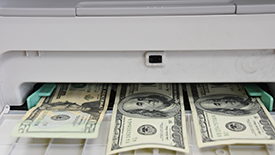Fake Products (and Money!) Are Big Business
How to protect yourself from modern-day counterfeiters
 Counterfeiters are getting better at tricking you. They do this by using fake images, creating realistic websites and promising low prices. According to the Organization for Economic Co-operation and Development (OECD), fraudsters hold an estimated 3.3% of world trade, up from 2.5% in 2016. Here are some commonly counterfeited items and what you need to know to protect yourself.
Counterfeiters are getting better at tricking you. They do this by using fake images, creating realistic websites and promising low prices. According to the Organization for Economic Co-operation and Development (OECD), fraudsters hold an estimated 3.3% of world trade, up from 2.5% in 2016. Here are some commonly counterfeited items and what you need to know to protect yourself.
Commonly Counterfeited Items
- Currency. The U.S. Treasury estimates that there are nearly $9 million of counterfeit bills in circulation. While creating an excellent counterfeit $100 bill would seem difficult, criminals can trick you if you aren’t paying attention.
- Shoes & Clothing. Manufacturing a low-quality knock-off and slapping a brand name label on a shirt or a pair of shoes is a tale as old as time. It’s much harder to spot a fake through online pictures and videos than seeing and touching it in person. With online purchases continuing to increase, it’s even easier to pull off this deception.
- Collectibles. Trading cards and collecting memorabilia are gaining in popularity over the past few years. People are willing to spend top dollar for a mint condition Fernando Tatis, Jr. rookie card or boxing gloves autographed by Mohammed Ali. Where there’s money, counterfeiters are looking to take advantage.
- Electronics. As technology continues to evolve, so does the ease of assembling electronics. Using cheap components and labor, companies can slap together their version of the real thing. This process cuts corners and sometimes skirts safety procedures that can lead to knock-off electronic products that can pose a hazard to your health.
How to Protect Yourself
- Know the real thing. The best way to spot a fake is to know the real thing inside and out. In the case of currency, the new $100 bills have plenty of watermarks, different textures and a security ribbon that make it difficult to fake. For products, do your research to know the characteristics of the legitimate item before you buy. Clues often come from irregularities in logos, colors and packaging.
- Shop from trusted sources. Shopping around for the lowest price is a wise practice. Automatically going with the cheapest option is not. If your purchase is important, stick to reputable vendors.
- Research, research, research. The more you know the product, the less likely you will be tricked. Look at products from local stores and read through reviews of online vendors. Conduct research on scams and common tricks used by counterfeiters. Be wary of reviews from the website you are thinking about making the purchase from. Instead, conduct a web search of both the product and the vendor to see what people have to say.
- Stay skeptical. When conducting your research, have the mindset that the product and company are fake until proven legitimate. If it seems too good to be true, it probably is.

